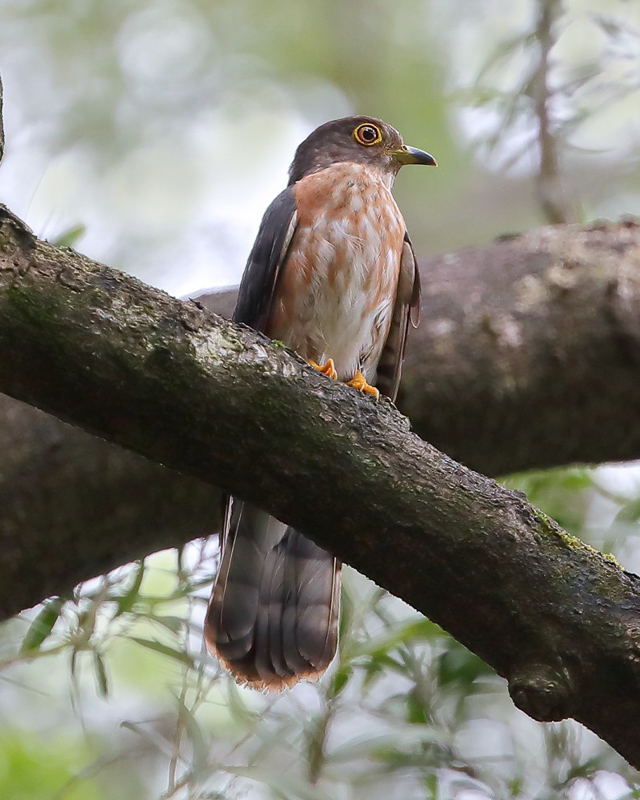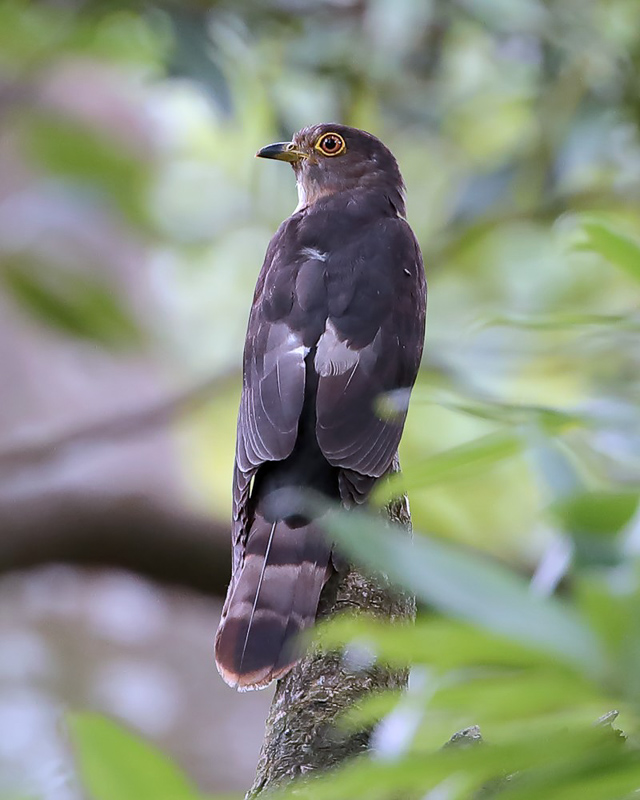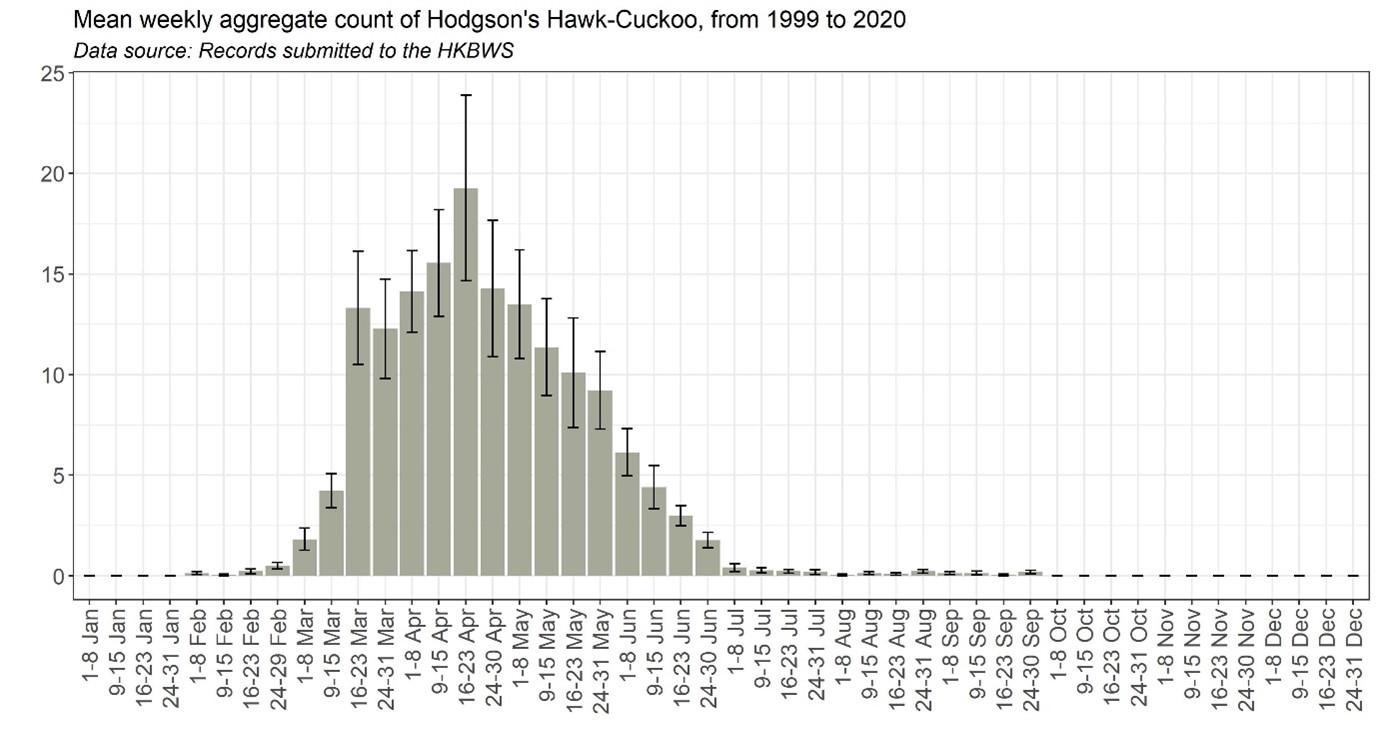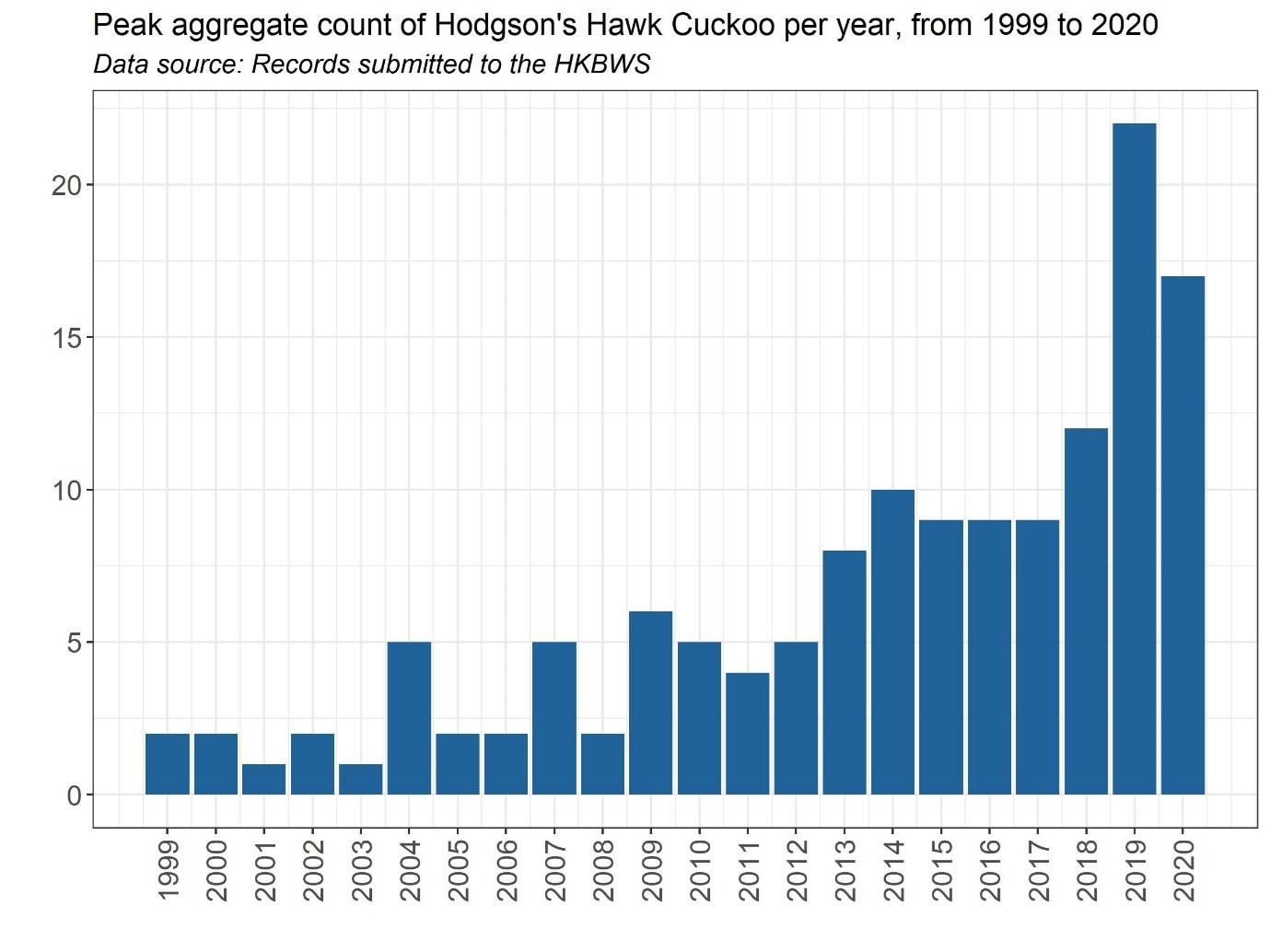Hodgson’s Hawk-Cuckoo Hierococcyx nisicolor 霍氏鷹鵑
Category I. Locally fairly common summer visitor and occasional passage migrant that has greatly increased since the 1990s.
IDENTIFICATION

May 2020, Michelle and Peter Wong. Adult.
38-40 cm. A slender-bodied, medium-sized cuckoo with a prominent bright yellow orbital ring. Adults have white underparts with extensive diffuse greyish-pink streaks.

May 2020, Michelle and Peter Wong. Adult.
Adults are bluish-grey on the head and upperparts, usually with a white tertial patch, and have a barred tail with a broad, dark subterminal bar bordered below by a mostly rufous tip and above by a narrow grey bar.

Aug. 2012, Michelle and Peter Wong. Juvenile.
Recently-fledged juveniles have a full blackish hood, pale-fringed blackish upperpart feathers, and white underparts heavily marked with dark brown or blackish spots. The tip of the tail is brownish while the pale bar immediately above the broad dark subterminal bar is greyish, which separates from Northern Hawk-Cuckoo (see Leader 2011).
VOCALISATIONS
The territorial call (presumably males only) is a far-carrying two-note hoarse whistle ‘eez-weet’, sometimes interspersed with a series of rapid, hoarser notes ‘whi-su-su-su-su-su-su’ which run up and down the scale.
DISTRIBUTION & HABITAT PREFERENCE
Hodgson’s Hawk Cuckoo occurs at altitudes up to about 700m across widespread parts of the New Territories and occasionally elsewhere, including Kowloon, HK Island, Lantau, Cheung Chau and Po Toi. Birds on territory show a strong preference for areas of closed-canopy forest and mixed shrubland and are sometimes found in stands of woodland near villages, especially fung shui woods. Birds on passage are occasionally encountered in urban parks.
OCCURRENCE
Hodgson’s Hawk-Cuckoo has been recorded between 14 March and 2 September (Figure 1), with April-May accounting for over 80% of records. Numbers reported rise rapidly in the third week of March and peak in the third week of April, but then fall steadily through May, June and early July, with only a trickle of records thereafter to the beginning of September, all involving single juveniles or first-years. Occasional migrants are also thought to occur (e.g., singles in urban parks at Tuen Mun on 16 April 2015 and Ho Man Tin on 14 April 2016 and a first-winter at Mui Tsz Lam on 13 August 2007). Nearly all records up to 8 July are of birds vocalising on territory.
The great majority of records are of one or two birds, with the highest among occasional larger numbers reported being nine in Tai Lam CP on 4 May 2019 and seven at Lai Chi Chong on 18 April 2018. Earliest and latest dates involve one in song at Pak Sha O on 14 March 2021 and a first-summer at Shing Mun on 2 September 2009.
The first record of this species was one heard and seen in Tai Po Kau during 14-15 April 1994. Following further records in Tai Po Kau on 3 April and on Cheung Chau on 7 April 1995, an increase in numbers and distribution occurred in in the years 1996-2000, with reports of the first juvenile (Wong Chuk Yeung, 30 July 1996), the first long-staying birds (Tai Po Kau and Chung Pui, April-May 1998), and the first record from HK Island (Mount Nicolson, 20 April 1996). The increase continued from 2001, with numbers rising steadily to the end of 2012, more sharply from 2013 and sharply again from 2019 (Figure 2).
BREEDING
At least ten different fledged juveniles have been reported since 1996, all between 18 July and 30 August and mostly in Tai Po Kau, including one on 24 August 2008 that was closely attended by a female Hainan Blue Flycatcher. A juvenile was seen being fed by a female Hainan Blue Flycatcher at KFBG on 31 July 2022.
BEHAVIOUR, FORAGING & DIET
Adults sing from within a tree or in flight both by day and night but are otherwise secretive in habits. Song is most frequent around sunset and early morning, but it is also heard at night, probably more so than Large Hawk-cuckoo.
RANGE & SYSTEMATICS
Monotypic. Breeds from Nepal and the east Himalayas through Burma and parts of Indochina to southern China, and winters to Sumatra, Java and Borneo (Payne 1997). In China, it is a summer visitor to Hainan and southern continental provinces from Yunnan east to Zhejiang and north through Sichuan to southern Shaanxi (Liu and Chen 2020).
CONSERVATION STATUS
IUCN: Least Concern. Population trend decreasing.
Figure 1.

Figure 2.

Leader, P. J. (2011). The Status and Identification of Hodgson’s and Northern Hawk-cuckoo in Hong Kong. Hong Kong Bird Report 2007-08: 347-359.
Liu, Y. and Y. H. Chen (eds) (2020). The CNG Field Guide to the Birds of China (in Chinese). Hunan Science and Technology Publication House, Changsha.
Payne, R. B. (1997). Family Cuculidae (Cuckoos) in del Hoyo, J., Elliot, A. and J. Sargatal. Handbook of the Birds of the World, vol. 4: Sandgrouse to Cuckoos. Lynx Edicions, Barcelona, Spain.

